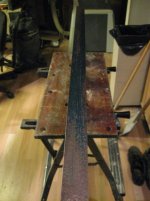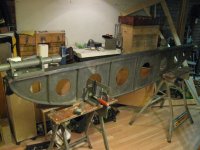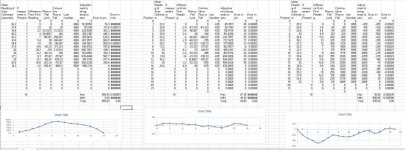Alex McGilton
Cast Iron
- Joined
- Apr 19, 2015
- Location
- Montreal, Canada
I hope the title describes my predicament. I have two camel backs that I intend to scrape straight to factory condition without access to a granite plate large or accurate enough. I got the 48 and 96 inch straight edges at auction in fairly good condition, immaculate scraped surface on both with visible wear on the ends of the small straight edge and non on the large one. See the first and third graph for the collimator results respectively. With the intentions of improving the two of them I started by scraping the small on to the large one over the long inclined section. What resulted was the second graph, slightly flatter but with a more wear resistant concave profile. Still have yet to fine scrape it should I decide to make it flatter then the large straight edge provides. The larger on I have yet to scrape but needs it more having a 0.00151" high crest. What I presume is that it was well scraped to an 8 foot B grade granite plate being permitted to have .002" of error.
The way that I had measured the entire flatness of the straight edge was to mount the collimator on the end, and having the mirror placed at the 1/4 point with the reading noted. The remaining 3/4 is measured before returning the mirror to the 1/4 point, inverted in direction with the collimator at the same noted measurement before measuring the remaining 1/4 was measured.
What I'm intending is to scrape down the middle of the larger camel back using only the small one for the rubbing and the collimator to check for flatness. My concern is that doing this I may obtain a twist in the large straight edge and have no way of observing or measuring this. Any thoughts on how to measure this would be appreciated. Would mounting a pair of levels both perpendicular to the straight edge be reliable enough to measure twist?
The way that I had measured the entire flatness of the straight edge was to mount the collimator on the end, and having the mirror placed at the 1/4 point with the reading noted. The remaining 3/4 is measured before returning the mirror to the 1/4 point, inverted in direction with the collimator at the same noted measurement before measuring the remaining 1/4 was measured.
What I'm intending is to scrape down the middle of the larger camel back using only the small one for the rubbing and the collimator to check for flatness. My concern is that doing this I may obtain a twist in the large straight edge and have no way of observing or measuring this. Any thoughts on how to measure this would be appreciated. Would mounting a pair of levels both perpendicular to the straight edge be reliable enough to measure twist?







